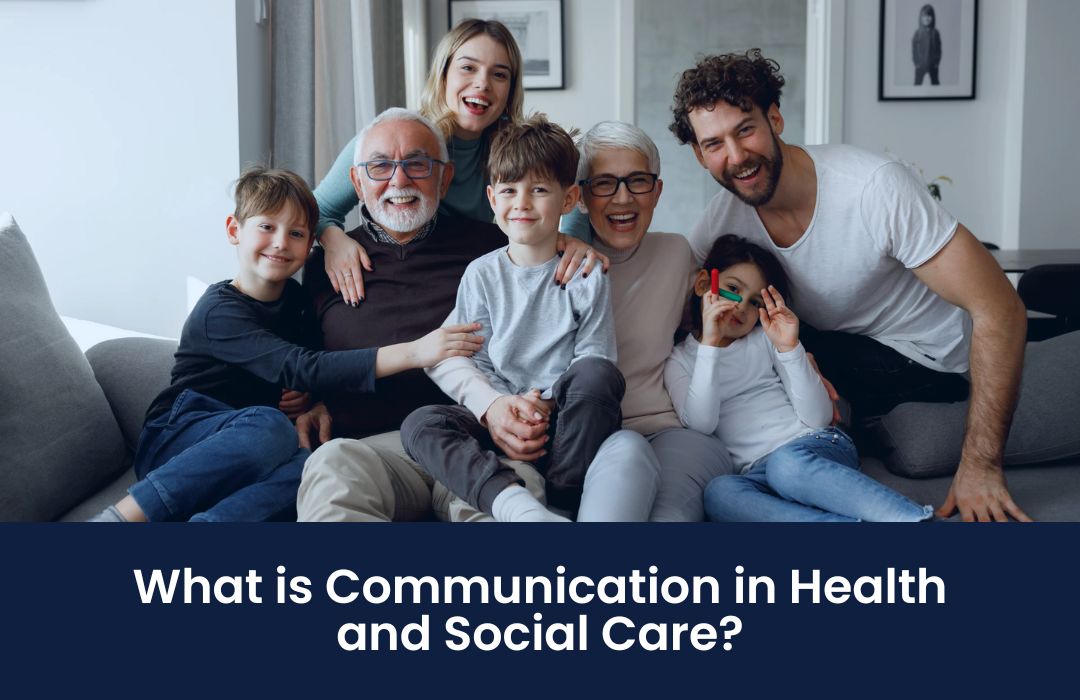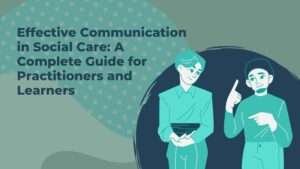Introduction
Effective communication is essential in health and social care environments. It guarantees that people feel heard and understood, that people receive the proper treatment, and that professionals collaborate well. Fostering a welcoming and inclusive healthcare environment where everyone may easily get the services they require depends on effective communication.
Strong communication skills are essential for healthcare workers to deliver high-quality treatment. All forms of communication—written, spoken, or nonverbal—are important for guaranteeing a seamless medical experience. This article will examine the various forms of communication used in health and social care, their significance, and real-world applications.
What is Communication in Health and Social Care?
Information sharing between healthcare providers, patients, and caregivers is referred to as communication in the context of health and social care. It can be communicated verbally, in writing, or even through facial expressions and body language. Patients are guaranteed to comprehend their diagnoses, available treatments, and treatment plans when there is effective communication.
In addition to promoting professional teamwork, clear communication helps to ensure coordinated treatment and avoid misconceptions that could jeopardize a patient’s health. It facilitates the development of empathy, trust, and the best results for those getting care.
Importance of Communication in Health and Social Care
For a number of reasons, good communication is essential in the health and social care sectors.
- Improves Patient Experience: Patients and healthcare professionals who communicate clearly have a better comprehension and experience less worry.
- Prevents Medical Errors: In healthcare settings, misunderstandings can result in inaccurate diagnoses, unsuitable treatments, or drug errors.
- Encourages Teamwork: To guarantee smooth care coordination, healthcare providers must communicate well with one another.
- Promotes Patient Participation: Patients are more likely to participate in their treatment and make wise decisions when they are aware of their care plans.
- Assures Adherence to Legal and Ethical Standards: In order to fulfill their ethical and legal obligations, healthcare workers must keep correct records and communicate clearly.
Examples of Communication in Health and Social Care
There are several ways to communicate effectively in the health and social care sectors. Here are a few instances from the actual world:
- To ensure understanding, a doctor will use clear language while explaining a diagnosis to a patient.
- To help a patient with low literacy understand prescription instructions, a nurse uses graphic aids.
- A social worker offers emotional support while actively listening to a client’s worries.
- A caregiver converses with a patient who has hearing loss using sign language.
- To make sure patients who don’t speak English comprehend their treatment plan, a hospital offers translated materials.
Communication in Health and Social Care Level 3
A key component of professional training at Level 3 in health and social care is communication. It entails comprehending:
- How to modify communication techniques to meet the demands of various patients.
- the value of empathy and attentive listening in patient care.
- Techniques for getting beyond obstacles like language hurdles and sensory impairments that prevent people from communicating.
- the way that technology, including telemedicine and electronic patient records, might improve communication.
Verbal Communication in Health and Social Care
Verbal communication is the most common form of interaction in healthcare settings. It includes:
- Face-to-face conversations between patients and healthcare professionals.
- Telephone consultations where medical advice is given remotely.
- Presentations and discussions during medical team meetings.
Verbal communication must be clear, professional, and tailored to the needs of the listener. Healthcare professionals should avoid using jargon and ensure that the patient fully understands the information being shared.
Non-Verbal Communication in Health and Social Care
Non-verbal communication includes body language, facial expressions, gestures, and eye contact. It plays a crucial role in:
- Building trust between healthcare providers and patients.
- Enhancing understanding when words are not enough, especially for patients with speech impairments.
- Reinforcing verbal communication by showing empathy and attentiveness.
For example, maintaining eye contact and using a calm tone can reassure anxious patients, while a warm smile can make them feel more comfortable.
Written Communication in Health and Social Care
Written communication is vital for record-keeping, reporting, and ensuring accurate patient care. It includes:
- Medical records and patient histories to track health progress.
- Prescriptions and medication instructions for proper drug administration.
- Care plans and discharge summaries to inform caregivers and family members.
- Emails and reports exchanged among healthcare teams.
Ensuring clarity, accuracy, and confidentiality in written communication is essential in maintaining professional standards in healthcare.
Importance of Effective Communication in Healthcare
The importance of effective communication in healthcare cannot be overstated. It is essential for:
- Reducing Medical Mistakes: Miscommunication can lead to serious health consequences, such as incorrect medication dosages.
- Improving Patient Satisfaction: Patients who feel heard and understood are more likely to have positive healthcare experiences.
- Strengthening Professional Relationships: Clear communication fosters trust and collaboration among healthcare teams.
- Ensuring Regulatory Compliance: Accurate documentation is critical for legal and ethical accountability.
By improving communication skills, healthcare professionals can deliver higher-quality care and build stronger patient-provider relationships.
Conclusion
The foundation of efficient health and social care is communication. All forms of communication, whether written, spoken, or nonverbal, are essential to maintaining patient welfare and the effectiveness of healthcare systems. Healthcare workers may deliver compassionate, inclusive, and high-quality treatment by honing their communication skills.
The healthcare sector can continue to enhance patient experiences, lower errors, and establish a more welcoming environment for everyone in need of care by acknowledging the significance of empathic and transparent communication.







